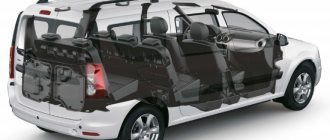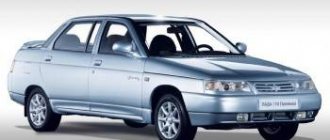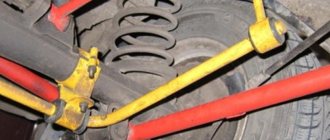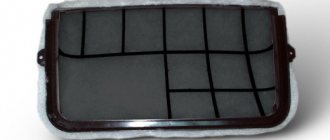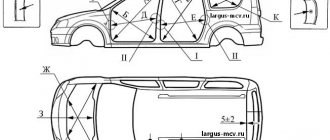Lada Samara is a whole family of cars, the production of which started in 1984. It included 6 models, each of which was distinguished by angular outlines. The last sedan of this family was the VAZ-2115, which was recognized as the best car of the Samara series. This model, in comparison with its predecessors, acquired a more streamlined body shape, which contributed to the growth of its sales on the Russian market. Over the years of the existence of this sedan, AvtoVAZ sold it in quantities exceeding 750 thousand copies. But, like other products of the Volga Automobile Plant, the VAZ-2115 Samara left production in 2012 due to the release of new models.
However, this car still remains one of the most popular cars on the secondary market. Therefore, it is not surprising that it regularly becomes the object of attention of tuners. But one of the designers went further and extensively redesigned the body of the Lada Samara 2021-2022, making it look like a business class model.
Car VAZ-2115
VAZ-2115 / Lada Samara is a four-door front-wheel drive sedan developed by the Volzhsky Automobile Plant).
The updated VAZ-2115 sedan was created as part of the Samara-2 project, work on which began in the early 90s. Moreover, thinking first of all about the new appearance of front-wheel drive cars, in Tolyatti they did not forget about aerodynamics. Therefore, in 1993, the VAZ design team came to the Dmitrov Automotive Test Site - the VAZ team decided to work on the style of the updated cars right in the wind tunnel!
We started by removing standard bumpers from ordinary VAZ-21093 and VAZ-21099 cars, and in their place they fitted new ones, which were fashioned from plasticine. The designers noticeably rounded the corners of the plasticine bumpers, and along the lower edge of the side doors they placed developed sill moldings that “flow” onto the edges of the wings. Using the same technology, a new, slightly longer and sharper “muzzle” was made. The appearance was complemented by a small wing on the trunk lid.
After several “purge” sessions in the wind tunnel, during which the shape of all parts was optimized, the designers came to the final version of the plasticine “armor”. And we went back to Togliatti. And a few months later, “live” Samara-2, embodied in metal and plastic, was driven to Dmitrov! These were the VAZ-2113 and VAZ-2114 hatchbacks - an alternative to the “eights” and “nines” - and the VAZ-2115 sedan, which was supposed to replace the “ninety-ninth” model. The Togliatti residents were generally satisfied with the results of the car purging and were already planning to prepare Samara-2 for mass production. The year was 1994.
Then the crisis came. The main forces and funds at the plant were devoted to finishing work on the “ten”, and funding for the Samara-2 project was severely cut. And as a result, of the three cars, they decided to bring only the VAZ-2115 to mass production. Almost two years were spent on this. Only in 1996, the “fifteenth” began to be produced in small batches at the VAZ pilot production facility. Since 2001, assembly began on the factory assembly line.
In comparison with its predecessor (VAZ-21099), the VAZ 2115 has lengthened by 225 mm. The appearance of the car has noticeably changed - the front and rear parts have been changed, the interior has been updated, while the sides, doors and roof remain the same. The new model is distinguished by the front part of the body with original headlights, a modified shape of the hood and front fenders, new taillights with an insert between them, bumpers painted in body color, a trunk spoiler with an additional brake light, door moldings, door sill fairings, a new trunk lid with floor level connector. New efficient lighting technology is provided.
A number of design solutions were borrowed from the “tenth” family of VAZs - an adjustable steering column, upper mounting points for front seat belts, and an instrument cluster. The rear number of the car, like on the “ten”, is located on the bumper.
The car is equipped with 1.5 and 1.6 liter petrol engines. Initially, modifications with a carburetor engine were produced. But in 2001, a modification was released with an engine with distributed fuel injection. To increase service life and reduce noise at idle, a new clutch driven disc with an idle damper is provided.
The display unit of the on-board control system carries information about closing the door locks, unfastened seat belts, extreme wear of the brake pads, the ignition key left, the level of oil, coolant and washer fluids. The new heater design used ensures efficient heating of the interior.
The VAZ-2115 is available in the following configurations: “standard” (VAZ-21150-20), “norm” (VAZ-21150-21) and “luxury” (VAZ-21150-22).
New items
The VAZ-2115 was part of the Lada Samara line of cars, and it was called a follower of the VAZ-21099. Of course, a lot remained from the “ninety-ninth”, but innovations did not bypass the model. The engineers at the factory did a good job and improved the electronics in the car. It came off the assembly line already equipped with power windows, which were now electric and eliminated the need for the driver to turn a handle to raise the window. Fog lights were also added. The VAZ-2115 stove deserves special attention. Judging by the reviews of owners of domestic cars, it was this device that was the weak point. In this direction, the manufacturer made several changes, which led to better performance of the device. However, problems were still observed.
A new control system was provided for all cars. With its help, the driver could monitor the condition of his car without leaving his seat. That is, it was possible to monitor the quality of the lamps, oil level and much more. This helped to immediately identify a specific breakdown, after which it was replaced. The VAZ-2115 with such equipment currently does not look special, since on-board computers are installed on other models. However, at that time (after all, almost 20 years had passed), this was precisely what distinguished it from other models of the Lada line.
Modifications of VAZ-2115
Initially, modifications were produced with a carburetor engine with a displacement of 1.5 liters. In the model range of AVTOVAZ JSC 2001-2002. modifications of the VAZ-2115 model with 1.1 liter engines are presented. (VAZ-2115 (1.1); volume 1.3 l. (VAZ-2115 (1.3) and engine, volume 1.5 l. with distributed fuel injection (VAZ-2115i)
| Modification | Power (hp) | Acceleration time (0-100 km/h) (s) | Maximum speed (km/h) | Start of release | Finish release |
| 2115 1.5L | 76 | 14 | 165 | 1997 | 2003 |
| 2115-20 1.5i | 78 | 13 | 170 | 2000 | — |
| 2115-91 1.3 R | 135 | 9 | 190 | 2001 | — |
- VAZ-2115-20 is a passenger car with a closed four-door sedan-type body. Engine with distributed fuel injection, displacement 1.5 l;
- VAZ-2115-01 is a passenger car with a closed four-door sedan-type body. Carburetor engine with a displacement of 1.5 liters.
- VAZ-2115-91 - Rotary piston engine, 1308 cc.
Release history
The assembly of the Lada Samara model began back in 1997 at the Volzhsky Automobile Plant. Having its origins in Togliatti, the car almost immediately began to actively sell out throughout Russia. The production of this car did not end even during the 2008 crisis, when AvtoVAZ found itself in a difficult situation due to debts.
VAZ-2115 was a follower of VAZ-21099, many still call them relatives. But in 2004, AvtoVAZ considered that it was time for the “ninety-ninth” to rest, and stopped producing it, completely replacing production with a more advanced model - the “fifteenth”. Of course, car enthusiasts did not abandon the VAZ-21099, and this car is still on sale.
Production of the VAZ-2115 model, better known as “Samara”, ended only in 2012. It was replaced by cars that were much more modern and safer. One of the followers of the “fifteenth” is the Lada Granta car, which also belongs to the budget segment, but more modernized.
Technical characteristics of VAZ-2115
| Total information | VAZ-2115 | |
| Dimensions, mm: length, mm width, mm height, mm | 4330 1650 1420 | |
| Base, mm | 2460 | |
| Front track, mm | 1400 | |
| Rear track, mm | 1370 | |
| Ground clearance, mm | 165 | |
| Turning radius, m | 5,2 | |
| Curb weight, kg | 985 | |
| Total weight, kg | 1410 | |
| Load capacity, kg | 425 | |
| Acceleration time 0–100 km/h, sec. | 14,2 | |
| Maximum speed, km/h | 158 | |
| Fuel | AI-95 | |
| Fuel capacity, l | 43 | |
| Fuel consumption (EU 99/100), l/100 km: at a speed of 90 km/h at a speed of 120 km/h urban cycle | 5,7 7,8 8,9 | |
| Body | ||
| Body type | sedan | |
| Number of doors | 4 | |
| Number of seats | 5 | |
| Trunk volume (VDA), l | 430 | |
| Engine | ||
| Location | front transverse | |
| Configuration | P4 | |
| Number of valves | 8 | |
| Working volume, cubic cm | 1499 | |
| Supply system | distributed injection | |
| Neutralizer | There is | |
| Toxicity standards | Euro 2 | |
| Compression ratio | 9,8 | |
| Power, kW/hp at rpm | 56,4/76,7 5400 | |
| Torque, N*m at rpm | 115,7 3000 | |
| Transmission | ||
| Type | front-wheel drive | |
| Transmission | M5 | |
| Chassis | ||
| Front suspension | McPherson type | |
| Rear half-link | elastic beam | |
| Steering | rack and pinion | |
| Front brakes | disk | |
| Rear brakes | drums | |
| Tire size | 165/70R13, 175/70R13 | |
| Equipment | Standard | Lux |
| Rear window defroster | There is | There is |
| Power windows for front doors | There is | There is |
| Heated front seats | No | There is |
| Immobilizer | There is | There is |
| On-board computer | No | There is |
| Fog lights | There is | There is |
| Exterior mirrors | with anti-glare effect | with anti-dazzle effect and electric drive |
| Seat upholstery | tweed | velvet |
| Vegetable padding on the front seat backs | There is | There is |
| Trunk spoiler with brake light | There is | There is |
| Tinted windows | No | There is |
Design
For quite a long time, the interior of cars under the Lada brand did not stand out in any way. But many people liked the appearance. In 2008, a decision was made to make a small change, as modern fashion for the appearance of a car had changed. The designers decided to change the moldings on the doors. If before 2008 they were wide and painted in a standard color on all cars, then after they were narrowed and the color scheme was changed.
Many say that these decisions have improved the appearance of the car, while some argue, on the contrary, that it has only made things worse. There were opinions that the car no longer stood out in the urban crowd.
Changes to the car compared to its predecessor
In the updated model, not only the external part of the car has radically changed, but the interior has also been significantly updated.
External differences from its predecessor:
- Bumper . The bumper became higher and was painted in body color, like foreign cars; before it, the 10, 11 and 12 models could boast of this.
- Headlights . The headlights became smaller and more rounded, and the optics themselves were quite modern at that time.
- Rear spoiler . Some trim levels were equipped from the factory with a small spoiler that did not differ in color from the car.
- Radiator trim and hood . The hood also differed favorably from its angular predecessor with its rounded shape, which made the 2114's design quite fresh.
- Wings . Slots for turn signals appeared in the wings and, in general, they began to integrate more advantageously into the overall appearance of the car.
- Side skirt fairings . The sills began to be covered with plastic covers and painted the same color as the body.
- Moldings . The moldings go along the doors and are in turn painted to match the color of the car's body.
History of creation
The very first representative of the family of cars with the code name “Samara-2”, the front-wheel drive sedan VAZ-2115, was developed to replace the VAZ-21099 sedan and, in fact, was its deep modernization. In general, the idea of modernizing cars of the Samara family, which includes the VAZ-21099 sedan and VAZ-2108 and VAZ-2109 hatchbacks, began almost immediately after the start of their serial production. The plans were grandiose, but at that time all efforts were devoted to the development of cars of the “tenth” family (VAZ-2110/11/12) and there was no time to modernize the Samara.
Auto-reactor
Samara-2 family appeared in 1997 as a further development of the popular front-wheel drive Samara ( Sputnik ) family. The first-born of the restyled family was the VAZ-2115 , which is actually a restyled version of the VAZ-21099 . Its exterior was “rejuvenated” due to new wings, hood and bumpers, as well as lighting equipment of a different shape, the trunk received a new lid with an opening to the bumper, but the central part of the body (salon) with doors was left unchanged. The capacity of the luggage compartment has increased from 365 to 427 liters in comparison with the “ninety-ninth” model. A plastic protective belt appeared along the lower perimeter of the body, and the sills were covered with aerodynamically shaped plastic overlays. The front wheel arches were equipped with practical arch extensions that prevent splashing on the sides of the body. A new instrument panel (popularly called the “European panel”) made of polypropylene facing the driver was installed on the “15th”. On it, in the “luxury” version, a set of warning lamps appeared for low levels of oil, coolant and washer fluid, wear of brake pads for locking doors and seat belts, a key left in the ignition, etc. A heater of an improved design also appeared. In general, the entire package of improvements made it possible to rename the modernized family “ Samara-2 ”.
Starting with the VAZ-2110 , each new model at VAZ is mastered in several stages: first, it is assembled in pilot production in small batches (using bypass technologies), its production volumes are gradually increased, and only then it is transferred to the main factory conveyor. The “15th” model went through the same procedure. Only in 2000 did it join the main conveyor belt of VAZ , and in the summer of 2004 it finally replaced the “099th” predecessor, whose production was transferred to the Ukrainian LuAZ. It is interesting that while the coexistence of two technically identical models lasted (unique for Western manufacturers), each of them had its own adherents.
The second model of the Samara-2 in 2000 was the five-door hatchback VAZ-2114 , created on the basis of the VAZ-21093 with an equipment package similar to the sedan. Unfortunately, the plant did not have enough funds to develop a new rear door, which, like the trunk lid on a sedan, should have reached the bumper (the lights would have been unified), so the rear of the “14th” body remained virtually unchanged. This does not interfere with the popularity of the model, which since the spring of 2004 has completely ousted the “nine” from production. VAZ-2113 model , created to replace the G8, appeared in production only in the fall of 2004.
The main engine for the Samara-2 gradually became the 8-valve 1.5-liter VAZ-2111 with a distributed injection system, although the first batches of the VAZ-2115 were equipped primarily with the “21083” carburetor engine, but with the 16-valve “2112” " Samara-2 " was never officially staged. In addition, in 1999-2002. In the OPP, version 2115-91 “Rotor” with a two-section VAZ-415 rotary piston engine was assembled to order piece by piece.
Possible malfunctions Engine :
- Failures and malfunctions of the GM injection system.
- Weak factory tightening of nuts and bolts of the transmission, engine and chassis. Alternator belt wear (50 thousand km).
- Wear of parts and components of the cooling system. Frequently change the oil filter.
- Poor engine mount design—destruction of the lower cross member of the engine compartment. Unreliability of Solex-type carburetors, especially EPHH.
Transmission:
- Failure of the gearbox drive shaft (models produced in late 1999 - early 2000 with a mileage of up to 50 thousand km).
- Wear of clutch discs on the “21083” engine (20-30 thousand km). Increased noise and play in the gear lever.
Chassis:
- Broken wheel alignment. Uneven brake force.
- Wear of silent blocks and loosening of suspension fastenings. Failures of the vacuum brake booster.
Electrical equipment:
- Electronics failures on the control panel.
- Poor quality connection of electrical wiring to terminals.
- Failures of electronic components (switch) of the ignition system of carburetor engines. Failures in the operation of the sound signal.
- Starter failures.
- Windshield wiper failures.
- Electric heater fan failures.
Body:
- Rough finish and large gaps in body and interior panels.
- Dirt accumulates under the overhead fender and sill extensions, leading to corrosion. Corrosion of mud flaps near the front suspension struts.
- Wheel arch corrosion.
- Corrosion of the A-pillars at the base. Radiator Frame Corrosion
- Leaf clogging of the ventilation system. Weak front seat frame.
Country of manufacture: Russia (Togliatti) Body: monocoque Body type: hatchback/sedan Number of doors: 3/ 4/ 5 Number of seats: 5 Drive type: front-wheel drive, engine in front transversely Suspension design: front McPherson strut, rear semi-independent on trailing arms Overall dimensions , mm 2113/ 2114: 4010x1650x1402 Overall dimensions, mm 2115: 4330x1650x1420 Wheelbase, mm: 2460 Ground clearance, mm: 160 Luggage compartment volume, l 2115: 390 Luggage compartment volume, l 2113/ 2114: 340/95 0 Curb weight, kg: 950-1095 Transmission: manual, 5-speed Tires: 175/70 R13
Production chronology 1997 - Start of production of the VAZ-2115 2001 - Start of production of the VAZ-2114 (small-scale) October 2004 - Serial production of the VAZ-2113
Modification of VAZ-2115 Engine type/number of valves* BV/ 4R/ 8 Displacement, l 1499 Power, hp 71 Maximum torque, N•m 118 Maximum speed, km/h 156 Acceleration to 100 km/h, s 12.2 Fuel consumption. 90 km/h/ GC, l 6.2/ 9.7
Modification of VAZ-2114 Engine type/number of valves* BV/ 4R/ 8 Displacement, l 1499 Power, hp 71 Maximum torque, N•m 118 Maximum speed, km/h 158 Acceleration to 100 km/h, s 12.0 Fuel consumption. 90 km/h/GC, l 6.1/ 9.5
Modification of VAZ-2113 Engine type/number of valves* BV/ 4R/ 8 Displacement, l 1499 Power, hp 71 Maximum torque, N•m 118 Maximum speed, km/h 160 Acceleration to 100 km/h, s 11.8 Fuel consumption. 90 km/h/ GC, l 6.0/ 9.5
* BV - gasoline, injection; BVT - gasoline, injection, turbocharging; BC - gasoline, carburetor; D - diesel; DNV - diesel with direct injection; DT - diesel, turbocharged; DNVT - diesel with direct injection, turbocharging; RPD - rotary piston Wankel engine.
The entry was published on November 28, 2008 at 09:53 pm and posted in the VAZ section, VAZ History. You can read comments using the RSS feed. The discussion is closed, but you can send a trackback from your site.
Let's sum it up
This model is unpretentious to use, it is easy to repair, and the parts are cheap. The technical characteristics and design of the car almost immediately attracted the interest of the younger generation of car enthusiasts. The most problematic place, according to drivers, is the stove.
After its appearance, the VAZ-2115 opened up great opportunities for fans of tuned cars. Almost everything in a car can be modified. In addition to the usual transformation of the appearance, craftsmen are engaged in tuning the engine, suspension, and brakes. After all the work has been carried out, it can be difficult to make out what brand the car was, since sometimes only the “original” body may remain from the car.
Buying a VAZ-2115 car (price varies within 100 thousand rubles) is available to everyone, but only on secondary markets. Therefore, purchasing such a car will not be difficult.
